Surprising Value of 2009 Lincoln Penny Bicentennial Cents
2009 Lincoln pennies in high Mint State grades are worth about $15. Coins in the most pristine condition and error coins can be worth over $100.
In 2009, the United States Mint marked the 200th anniversary of Abraham Lincoln’s birth with a four-coin series of circulating commemorative cents. Known as the “Lincoln Bicentennial” series, the program consisted of four different reverse designs marking major milestones in Lincoln’s life. Even today, you can often still find these one-cent coins in your spare change.
By far the most valuable Bicentennial cents are error coins, also called "mint errors." We will discuss those first. You can scroll farther down to read about the designs and mintages of these four coins.
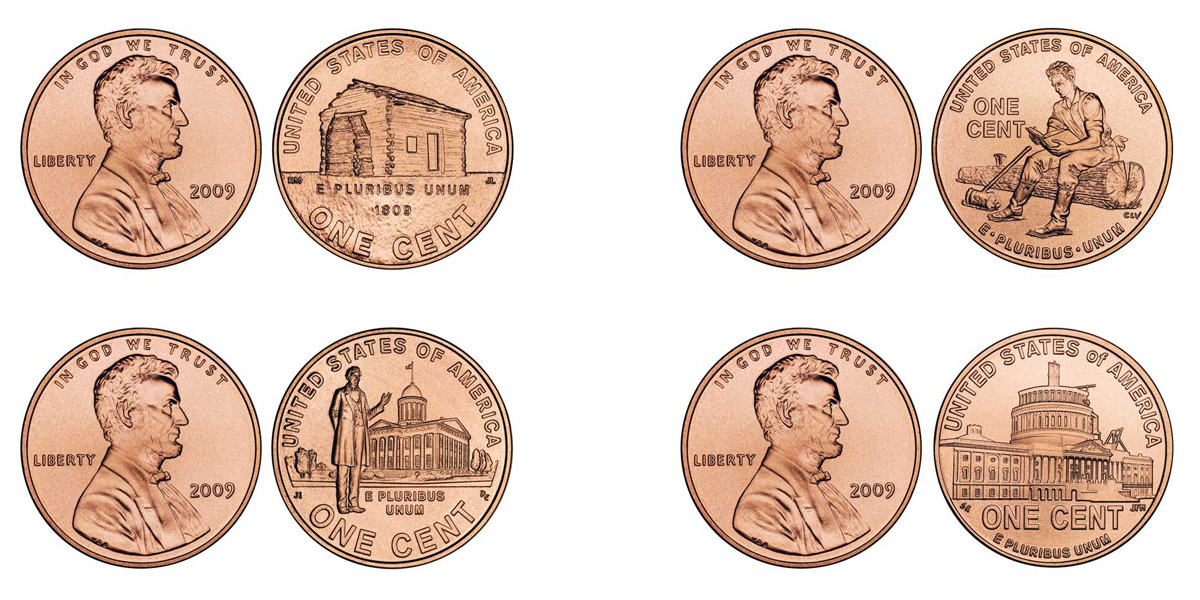
All images courtesy of USA CoinBook unless otherwise noted
The Value of a 2009 Lincoln Cent
The combined total mintage numbers of all four designs from both the Philadelphia Mint and Denver Mint was more than 2.3 billion coins. Combined with the fact that many millions of Lincoln Bicentennial cents were saved by the public, it is small wonder that they are so seldom seen in circulation.
That hoarding also explains why a Lincoln Bicentennial cent is not worth much more than face value in any grade less than MS65. A certified 2009 Lincoln cent grading MS65 often sells for around $15. Prices escalate from there, to around $100 for a MS67.
2009 Lincoln Bicentennial Cent Price Chart
The coin's condition will greatly determine its value. Uncirculated coins in mint condition (mint state) will always be worth more than those with lower grades. Proof coins are oftentimes more desirable than regular coins, as well. You can learn more about the coin grading system by following the link.
*Prices below are quoted from NGC Coin Explorer for coins designated "Red" (RD) in the finest known grade. Values for coins designated "Red-Brown" (RB) or "Brown" (B) will typically be lower. For proofs, coins with the "Ultra Cameo" designation tend to garner higher prices.
| 2009-P Birth and Early Childhood in Kentucky | $30 | MS67 |
| 2009-P Birth and Early Childhood in Kentucky (Satin Finish) | $60 | MS69 |
| 2009-D Birth and Early Childhood in Kentucky | $30 | MS67 |
| 2009-D Birth and Early Childhood in Kentucky (Satin Finish) | $50 | MS69 |
| 2009-S Birth and Early Childhood in Kentucky (Proof) | $45 | PF70 (Cameo) |
| 2009-P Formative Years in Indiana | $25 | MS67 |
| 2009-P Formative Years in Indiana (Satin Finish) | $50 | MS69 |
| 2009-D Formative Years in Indiana | $25 | MS67 |
| 2009-D Formative Years in Indiana (Satin Finish) | $65 | MS69 |
| 2009-S Formative Years in Indiana (Proof) | $15 | PF69 (Cameo) |
| 2009-P Professional Life in Illinois | $35 | MS67 |
| 2009-P Professional Life in Illinois (Satin Finish) | $30 | MS69 |
| 2009-D Professional Life in Illinois | $35 | MS67 |
| 2009-D Professional Life in Illinois (Satin Finish) | $40 | MS69 |
| 2009-S Professional Life in Illinois (Proof) | $85 | PF70 (Cameo) |
| 2009-P Presidency in Washington, D.C. | $35 | MS67 |
| 2009-P Presidency in Washington, D.C. (Satin Finish) | $100 | MS69 |
| 2009-D Presidency in Washington, D.C. | $2,500 | MS69 |
| 2009-D Presidency in Washington, D.C. (Satin Finish) | $90 | MS69 |
| 2009-S Presidency in Washington, D.C. (Proof) | $75 | PF70 (Ultra Cameo) |
2009 Lincoln Cent Errors and Varieties
There are many instances of errors on the different 2009 Lincoln cent mintages, but the supply of most of them is greater than collector demand. PCGS only recognizes one set of varieties—the die doubling on Lincoln’s hand on the “Formative Years” design.
Nonetheless, the error coins described below can often garner hundreds of dollars from collectors.
Errors on “Birthplace in Kentucky" 2009 Lincoln Cents
Look for die doubling on the ends of the logs in the front left corner of the log cabin. The doubling will generally affect only two or three logs. These logs can be in different places. Sometimes the E in ONE and the C in CENT are doubled.
Errors on “Formative Years” 2009 Lincoln Cents
The doubled die errors on the “Formative Years” 2009 Lincoln cent are the most visible and dramatic errors of the series. These varieties involve doubled fingers or thumbs. This is the only series of 2009 Lincoln cent varieties recognized by PCGS, which lists eight different doubled die reverses.
These errors can be thought of as similar to the “extra corn leaf” doubled die reverses on the 2004-D Wisconsin state quarter in visibility and popularity.
Errors on “Professional Life” 2009 Lincoln Cents
Die errors on the 2009 “Professional Life” Lincoln cent are concentrated on the third upstairs window to the left, where filled-in window panes and doubled window sills are the most common ones found.
Errors on “Presidency” 2009 Lincoln Cents
Doubled die reverses on the “Presidency” 2009 Lincoln cent are most often present on the upper and lower window panes on the front of the Capitol. Some DDRs appear on the front door of the Capitol and nearby windows.
The 2009 Lincoln Bicentennial Designs
The front design (obverse side) for Lincoln pennies remained the same in 2009. It used the original design by sculptor Victor David Brenner.
The difference with the new commemorative coins was the 2009 Lincoln penny back designs (reverse) that depicted different periods in Lincoln's life. They replaced the Lincoln Memorial design used from 1959 to 2008.
The first commemorative reverse, named “Birth and Early Childhood in Kentucky” showed a rough log cabin similar to the one where Lincoln was born. This is sometimes called the "log cabin penny."
The second design was named “Formative Years in Indiana.” This design portrayed a young adult Lincoln taking a break from rail splitting and studying with a book. Lincoln was largely self-taught as a young man.
The third design, “Professional Life in Illinois,” shows Lincoln in front of the Illinois State Capitol in Springfield. Lincoln worked as a lawyer in Springfield and served in the state Legislature.
The fourth and final design in the series was named “Presidency in Washington DC.” It shows the US Capitol under construction, as it appeared on the day of Lincoln’s first inauguration. This scene is meant to invoke Lincoln’s determination to rebuild the nation from the “house divided” caused by the Civil War.
2009 Lincoln Cent Designs and Mintages
All 2009 Lincoln cents retained the obverse by Victor D. Brenner that has been in use since the Lincoln cent was introduced in 1909. The circulation strike 2009 Lincoln Bicentennial cents were produced on the normal copper-clad zinc core blanks. The four 2009-S Proof Lincoln cent designs and the satin finish Lincoln cents in the 2009 Uncirculated Set were struck from 95% pure copper—the first time Lincoln cents had been made of copper since 1982.
1: Birthplace in Kentucky
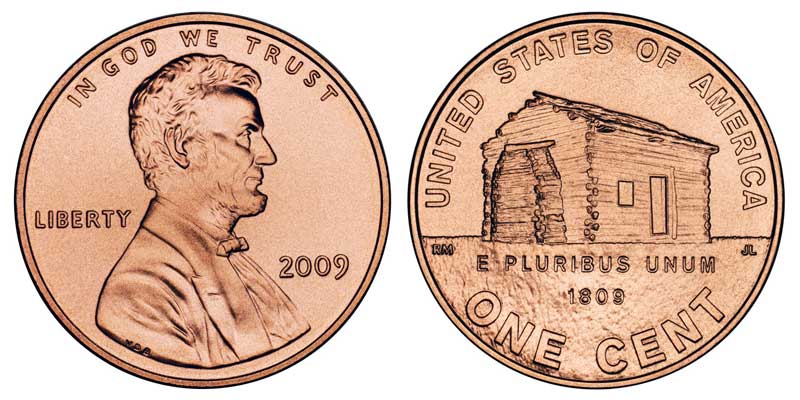
2009 Lincoln Bicentennial cent (Birth and Early Childhood)
Released: February 12, 2009 (Lincoln’s 200th birthday) in Hodgenville, KY
Mintages:
(P): 284,400,000
D: 350,400,000
The log cabin scene on the reverse was designed by Richard Masters, and sculpted by Jim Licaretz.
2: Formative Years in Indiana
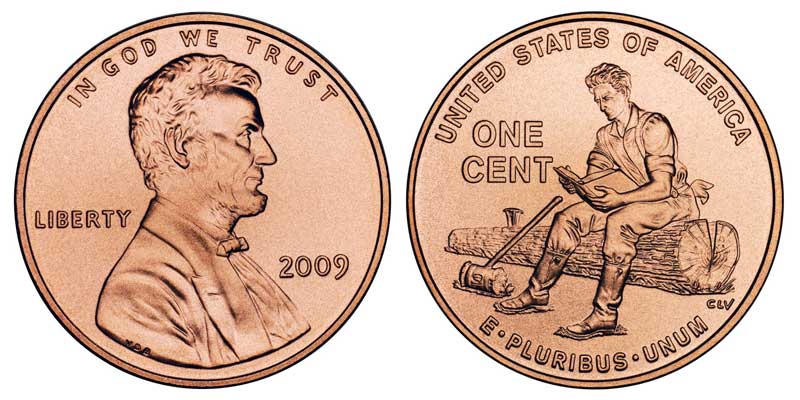
2009 Lincoln Bicentennial cent (Formative Years)
Released: May 14, 2009 in Lincoln City, IN
Mintages:
(P): 376,000,000
D: 363,600,000
The depiction of the young “railsplitter” Lincoln was designed and sculpted by Charles L. Vickers.
3: Professional Life in Illinois
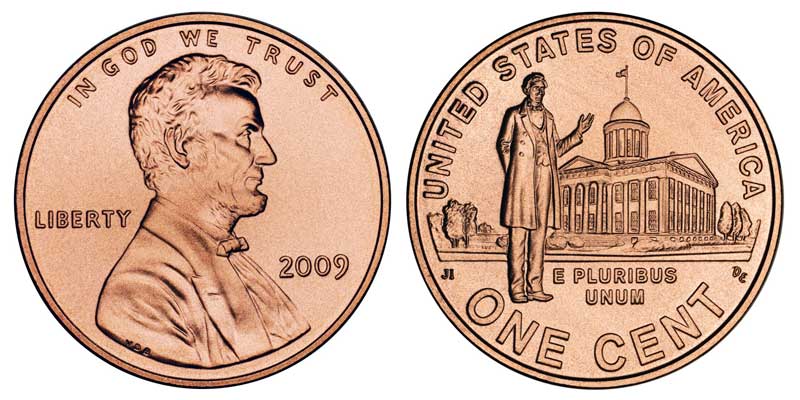
2009 Lincoln Bicentennial cent (Professional Life)
Released August 13, 2009 in Springfield, IL
Mintages:
(P): 316,000,000
D: 336,000,000
This depiction of Lincoln as lawyer and statesman standing in front of the Illinois state capitol building was designed by Joel Iskowitz and sculpted by Don Everhart.
4: Presidency in Washington DC
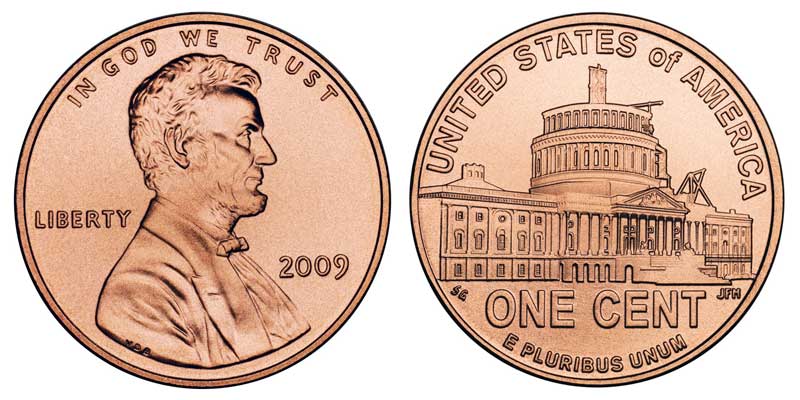
2009 Lincoln Bicentennial cent (Presidency)
Released November 12, 2009 in Washington, DC
Mintages:
(P): 129,600,000
D: 198,000,000
This reverse was designed by Susan Gamble and sculpted by Joseph Menna. It shows the United States Capitol building while under construction.
2009 Proof Lincoln Cents
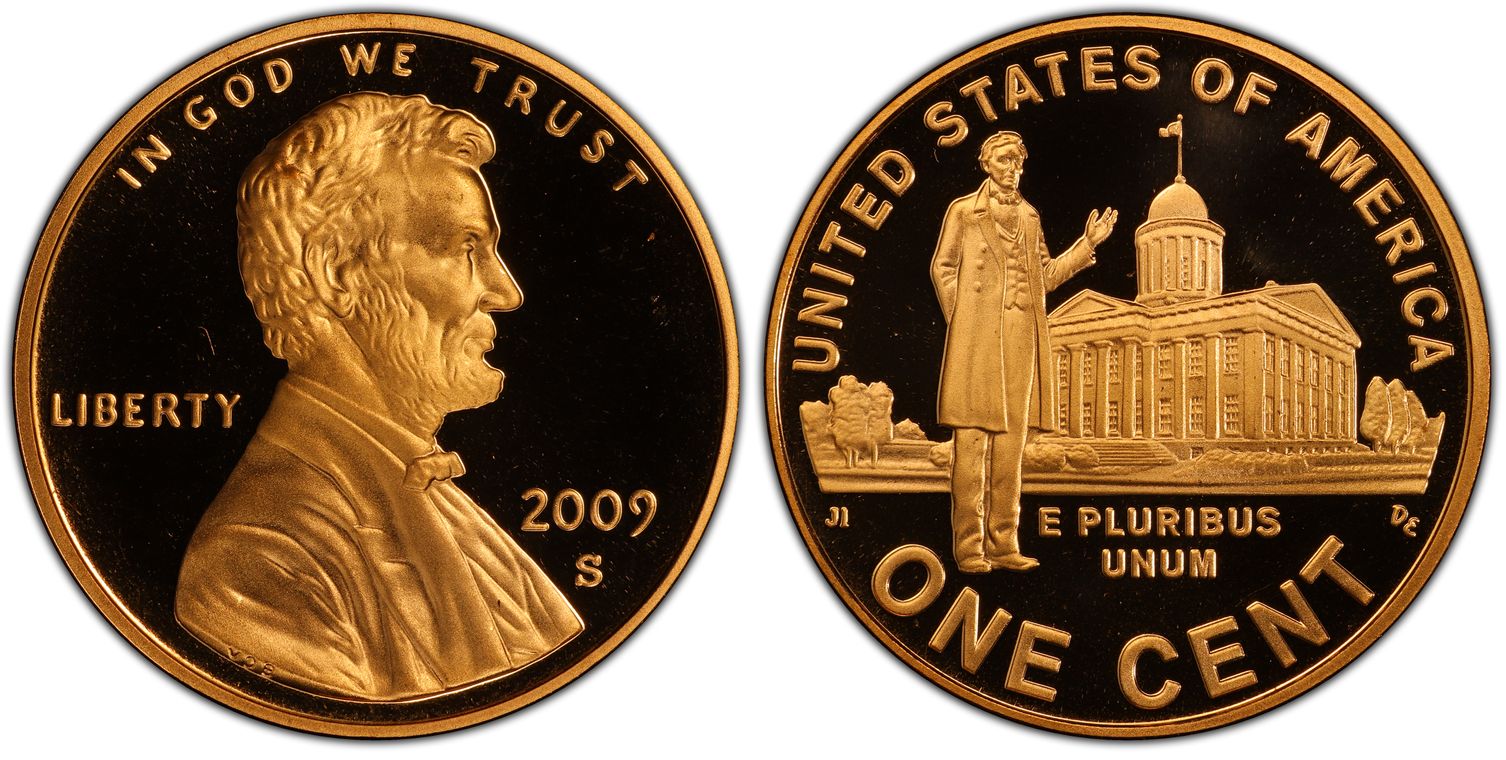
Proof 2009-S “Professional Life” Lincoln cent. Courtesy of PCGS
There were 2,995,615 Proof Sets made in 2009.
The proof 2009 Lincoln cent designs were struck with a mirror finish in the fields with frosted features. They were struck on solid 95% copper bronze planchets, just like the original 1909 Lincoln cent. The proof 2009-S Lincoln cents were only available in the 18-coin 2009 Proof Set, made at the San Francisco Mint.
In addition to the four proof 2009 Lincoln cents, each set contained four proof Presidential dollar coins, one proof Sacagawea dollar coin, six proof State quarter designs, one proof dime, one proof nickel, and one proof Kennedy half dollar.
2009 Satin Finish Lincoln Cents
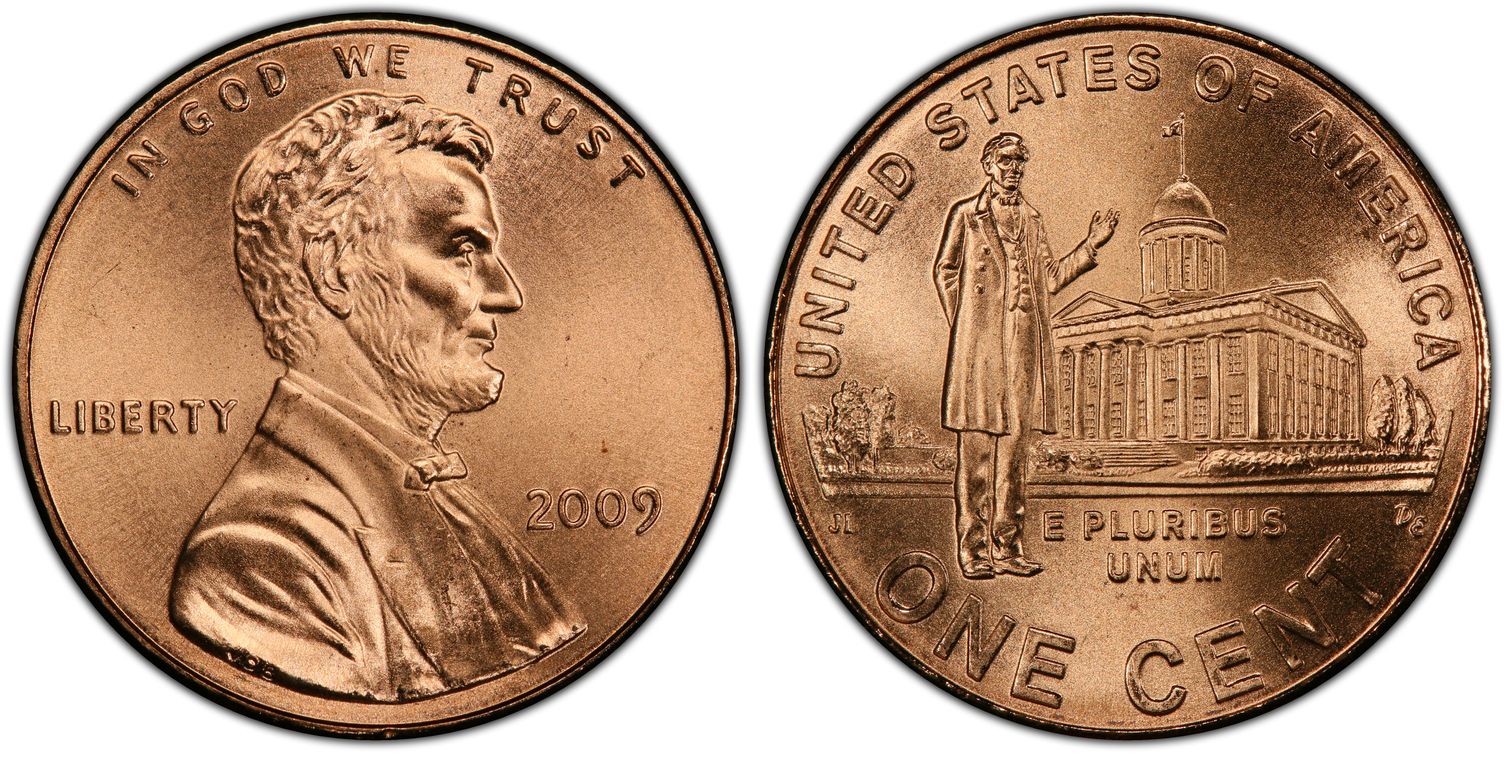
Satin-finish “Professional Life” 2009 Uncirculated Lincoln cent. Courtesy of PCGS
784,614 Uncirculated mint sets were produced in 2009.
The satin-finish 2009 Lincoln cents were only issued as part of the 2009 Uncirculated coin sets. These sets used special burnished dies and a special strike to give a satin finish to the fields on each coin.
The 2009 Uncirculated coin set comprised 36 coins, double the number in the Proof sets. These sets featured all 18 coin designs and denominations issued in 2009 for both the Philadelphia and Denver Mints.
Lincoln Cent Shield Design
.jpg)
Lincoln cent Shield reverse. Courtesy of US Mint
After the 2009 Lincoln Bicentennial celebrations were done, the cent returned with a new permanent reverse. Building on the sentiment conjured by the 2009 designs, the new “Union Shield” Lincoln cent harkens to a patriotic, reunited Union after the Civil War.
Read more about U.S. Mint coins from the authors at Gainesville Coins:
1943 Steel Penny Value: How Much They Are Worth Now
What Are the Different Penny Errors and What Are They Worth?
Morgan Dollar Key Dates: Collecting Tips & Prices
Key Date Peace Dollars: Collecting Guide & Prices
Walking Liberty Half Dollar Values (1916–1947)
Modern Quarters Worth Money: Prices & Collecting Tips
Most Valuable Dimes: Comprehensive List for Collectors
Coin Collecting for Kids: A Beginner's Guide

Steven Cochran
A published writer, Steven's coverage of precious metals goes beyond the daily news to explain how ancillary factors affect the market.
Steven specializes in market analysis with an emphasis on stocks, corporate bonds, and government debt.
